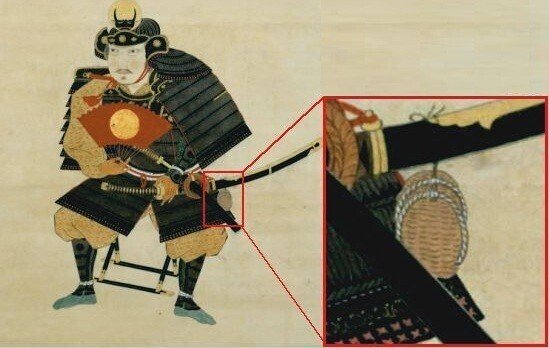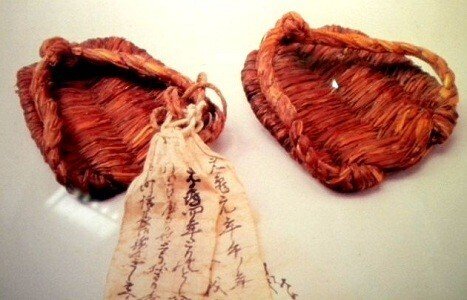
The Prize to Kanematsu Masayoshi — Tonezaka, 10 September 1573

Oil on canvas, 65.2×80.3 cm, 2012-2022, M.Tsushima
Nobunaga, served by innumerable people, must have conducted a reward management to gain and keep the loyalty of his men. He motivated his retainers by giving them lands, money and treasures as rewards, but he showed, in this episode, that the best reward was not necessarily expensive.
Background
In September 1573, Nobunaga made war with Asakura Yoshikage who ruled Echizen Province. Asakura led his army of 20,000 to the northern Omi Province but when he found his forts lost to Nobunaga, Asakura began to retreat. Nobunagas's army soon pursued Asakura's troops and caught up at Tonezaka, where Nobunaga's soldier, Kanematsu Masayoshi, chased an opponent soldier in the mountain, and killed him, and brought the enemy's head back to Nobunaga. He was barefoot then, and his feet were bleeding red. Nobunaga prized him with a pair of sandals that Nobunaga ordinary carried on his waist.
Accounts
Ota Gyuichi(1527-1613), samurai who served Nobunaga, writes[1]:
Incidentally, Nobunaga ordinary carried on his waist a pair of ashinaka sandals. This time in the Tone Mountain, Kanematsu Matashiro chased a mounted samurai soldier in the mountain, and eventually killed him, and brought the enemy's head back to Nobunaga. At that time, Kanematsu was barefoot, and his feet were bleeding red. Nobunaga seeing him said "these will be useful" and gave to Kanematsu the ashinaka sandals that Nobunaga ordinarily carried on his waist. It was the ultimate bliss, it was the honor.
Kanematsu Masayoshi
Kanematsu Masayoshi was a low rank samurai in Owari Province, but his contributions to Nobunaga's victories in the wars to unify Owari Province promoted him to Nobunaga's mounted guard.
In 1573, Kanematsu served Nobunaga's campaign against Azai and Asakura clans. At the battle of Tonezaka, Kanematsu, 31 years old, chased an enemy samurai soldier, Nakamura Shinbei, in the mountain, and killed him, and brought the enemy's head back to Nobunaga. (Samurai warriors took enemies' chopped heads for an assessment of military performance.) He, then barefoot, was given by Nobunaga a pair of sandals called ashinaka.

Ashinaka sandal
So what is an ashinaka sandal?
In the 16th century, Japanese did not wear shoes but sandals. Samurais and soldiers wore even peculiar sandals called ashinaka. Luis Frois, Jesuit missionary to Japan, wrote about it[2]:
In Europe, you would be laughed at if you wore sandals that cover only half of the feet. In Japan, it is a fine thing. The complete ones are of bonzes, ladies and elders.
We walk on the whole foot. Japanese walk on the forefoot wearing half-foot wears.
Ashinaka, meaning a half foot, is a sandal that covers only forefoot.
So why did Japanese soldiers wore ashinaka sandals?
Ashinaka sandal spread in the 13th century when samurais raised their social rank.

The lightweight sandal is simply good for running. In addition, the ashinaka sandal, unlike a complete sandal, did not throw in it pebbles or sand that would offend the soldiers before fighting enemies. It was also durable, hard to tear, so it was popular among samurai soldiers who would serve long-lasting wars.
In the 16th century, not only soldiers but also even warlords wore ashinaka sandals. It already symbolized samurai status, though there was little or no development in its shape or materials. At the battle of Tonezaka in 1573, Nobunaga as well had ashinaka sandals that had nothing special; they were cheap ashinaka sandals made of straw.
The Prize
The enemy Kanematsu Masayoshi killed proved to be an Asakura's retainer, mounted samurai soldier, so, he would expect a large reward. However, what made Kanematsu famous was not a reward of vast land or much money, but a pair of cheap sandals given by Nobunaga.
Nobunaga at that time had sandals on his waist. So why did he that?
Nobunaga, from his youth, ordinarily carried on his waist things like flintlock bags, several gourd bottles[1], that an ordinary landlord did not carry by himself. Nobunaga was a man of pragmatism; he carried useful things, even people thought it peculiar. So, during the war he carried ashinaka sandals probably for his own use as a backup, not for giving his men as prizes.
Nobunaga gave Kanematsu his ashinaka sandals with saying that they would be useful. Kanematsu then was barefoot; he had worked in the mountain so hard that he had lost his own sandals. It would be hard for him to continue the battle barefoot. Did Kanematsu wear the given sandals in the ongoing war? We don't know. But what is certain is that, for Kanematsu, they were more than practical use. The receiving the sandals, as a Nobunaga's retainer Ota Gyuichi writes, was the honor.
The sandals of honor were passed down in Kanematsu family for generations. Today in the 21st century, they are housed in the Nagoya City Hideyoshi Kiyomasa Memorial Museum.

References
[1] 信長公記, 太田牛一
[2] 日欧文化比較, Luis Frois
[3] 蒙古襲来合戦絵巻 (1) p20/45
Nobunaga on Canvas
https://nobunagaoncanvas.blogspot.com/2022/05/the-prize-to-kanematsu-masayoshi.html
